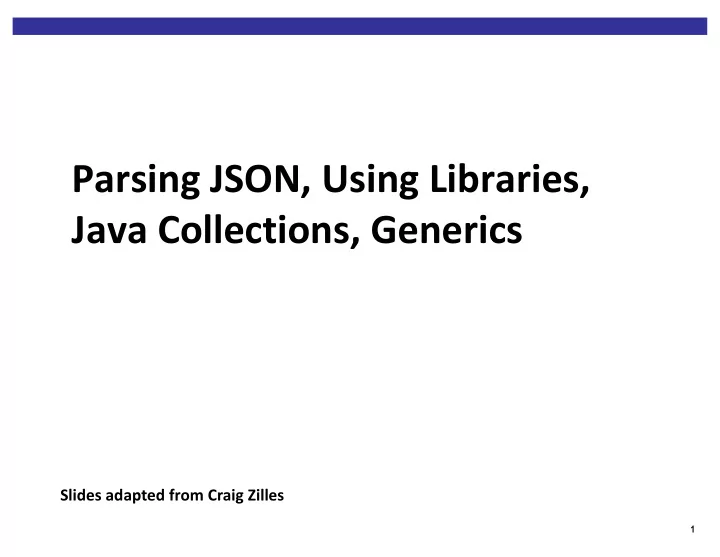

Parsing JSON, Using Libraries, Java Collections, Generics Slides adapted from Craig Zilles 1
CamelCaser Difficulty How difficult was the first assignment? A. Easy B. Moderate C. Challenging D. Unreasonable 2
CamelCaser Time How long did it take you to complete the assignment? A. Less than 2 hours B. 2 to 4 hours C. 4 to 6 hours D. 6 to 8 hours E. More than 8 hours 3
JSON (www.json.org) ¢ JavaScript Object Notation ¢ A lightweight data-interchange format § Very commonly used by APIs ¢ It is easy for humans to read and write. ¢ It is easy for machines to parse and generate. 4
Example JSON object { name_of_a_string: “a string”, name_of_a_number: 2080.8827, objects_can_be_values: { here_is: “another object” }, an_array: [ 27, “word”, { objects_can: “be in arrays” } ] } 5
Using APIs (e.g., https://newsapi.org) ¢ API = Application Programming Interface ¢ Get an API key ¢ Grab some JSON: § https://newsapi.org/v1/articles?source=associated- press&sortBy=top&apiKey=YOUR_API_KEY_HERE ¢ JSON formatter/pretty printer § https://jsonformatter.curiousconcept.com § There are a bunch of these, use your favorite 6
Parsing JSON in Java ¢ Use the GSON library from Google § https://github.com/google/gson/blob/master/UserGuide.md § Use Maven to add the library to your project ¢ Build classes with fields for the desired elements of the JSON § Use the same names and get the types right ¢ Instantiate a Gson object § Gson gson = new Gson(); ¢ Use the fromJSON method to parse the JSON § Thing newThing = gson.fromJson(jsonString, Thing.class); § Thing [] thingArray = gson.fromJson(jsonString, Thing[].class); ¢ Extended example using NewsAPI 7
What if we want to filter News Articles? ¢ E.g., only select those articles with specific authors ¢ What should be the return type of such a function? 8
One Implementation public NewsArticle[] removeNullAuthorArticles(NewsArticle[] input) { // output array can’t be bigger than input array NewsArticle [] output = new NewsArticle[input.length]; int outputIndex = 0; for (int i = 0; i < input.length; i++) { if (input[i].getAuthor() != null) { output[outputIndex] = input[i]; outputIndex ++; } } return output; } 9
Java Collections ¢ collection: an object that stores data; a.k.a. "data structure" § the objects stored are called elements § some collections maintain an ordering; some allow duplicates § typical operations: add , remove , clear , contains (search), size § examples found in the Java class libraries: § ArrayList , HashMap , TreeSet § all collections are in the java.util package import java.util.*; 10
Java Collection Framework 11
Lists ¢ list: a collection storing an ordered sequence of elements § each element is accessible by a 0-based index § a list has a size (number of elements that have been added) § elements can be added to the front, back, or elsewhere § in Java, a list can be represented as an ArrayList object 12
ArrayList Methods (partial list) add( value ) appends value at end of list add( index , value ) inserts given value just before the given index, shifting subsequent values to the right removes all elements of the list clear() indexOf( value ) returns first index where given value is found in list (-1 if not found) get( index ) returns the value at given index remove( index ) removes/returns value at given index, shifting subsequent values to the left set( index , value ) replaces value at given index with given value returns the number of elements in list size() returns a string representation of the list toString() such as "[3, 42, -7, 15]" 13
Generics ArrayList< Type > name = new ArrayList< Type >(); ¢ When constructing an ArrayList , you must specify the type of elements it will contain between < and > . § This is called a type parameter or a generic class. § Allows the same ArrayList class to store lists of different types. § Must be objects (vs. primitive types) 14
Boxed Primitive Types ¢ Can’t do ArrayList<int> ¢ Java provides “boxed primitives”: E.g., Integer § Sub-class of object ¢ Can do: § ArrayList<Integer> lengths = new ArrayList<Integer> § lengths.add(7); // automatically promoted to boxed type Primitive Type Wrapper Type int Integer double Double char Character boolean Boolean 15
To Dos for Next Tuesday ¢ Read chapter 4 of your book “Aesthetics” ¢ Read section 4 (Formatting) of the Google Java Style Guide ¢ Take Policy Quiz ¢ Assignment for next week’s code review: § Parsing JSON for UofI course grade distributions § Filtering and aggregating data from this sources § Out now 16
Recommend
More recommend